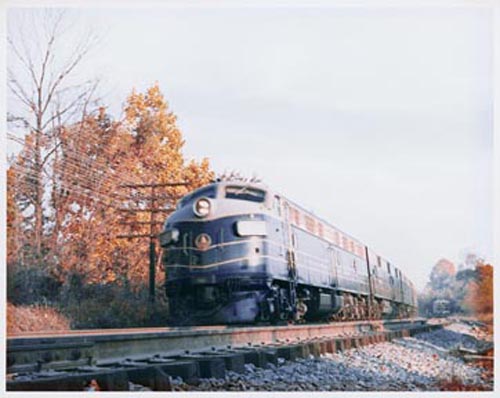By Paul Seidenman
It was especially beautiful, that fall of 1964. That year, the Indian summer, so typical of the mid-Atlantic states, seemed to stay a little longer than usual. It was a good time to watch and photograph trains.
For me, there were always the trains. I grew up in Silver Spring, a Maryland suburb of Washington, D.C., barely a mile from the Baltimore & Ohio’s Metropolitan Branch-the busy steel thruway which thrust westward to meet the Old Main Line at Point of Rocks. Living so close to the tracks, I was never out of earshot of the heavy coal drags and the “Time Saver” and “Sentinel” redball freights that banged through behind heavy steam and early diesel power. And, of course, there were still the numerous no-name, workaday passenger locals, intermingled with the sleek, long-distance expresses with names like Capitol Limited, Columbian, National Limited, Shenandoah, Ambassador, and Diplomat. They were a presence that, like the beautiful fall I remember, seemed destined never to go away.
For the train-struck little boy that I was, the B&O was a friend I felt would always be there. And as I grew up, one thing had not changed. There was still something beautiful about the sight of a train.
In the fall of 1964, I still lived near the B&O and the trains continued rolling past. But by this time, steam had gone. The railroad’s great fleet of limiteds was shrinking. The through Pullmans to California and Texas, once interchanged at Chicago and St. Louis with trains named Super Chief, Eagle, and Texas Special no longer ran. Yet the Metropolitan Branch was still a showcase of trains.
There was one Sunday of that fall when, with 35mm camera in hand, I walked along the B&O at Georgetown Junction, waiting for trains. The junction was where the Georgetown Branch, a meandering 12-mile industrial spur, joined the Metropolitan. Six days a week, it hummed with activity as little switchers or occasional road power would shove boxcars, gondolas, and hoppers into and out of the grimy industrial park near the main line, or down to the Georgetown waterfront along the Potomac River. But this was Sunday, and all the Georgetown Branch had to offer was a lone covered hopper, slumbering the afternoon away on a rusty, weedgrown siding.
Not much was happening along the Metropolitan Branch when I got there on that late afternoon, but as the hands of my watch approached 5:30, I knew that would soon change. If the Capitol was on schedule, it would just be stopping at the red-brick Silver Spring station to take on additional passengers, mail, and express for its overnight dash to Chicago. Only a couple of miles east of Georgetown Junction, Silver Spring was B&O’s suburban Washington stop for all of its passenger trains to and from Washington and the west. For No. 5, the dwell time at the little station was usually brief, and that afternoon was no different. B&O’s flagship would be on time.
In the distance I could detect the faint roar of the Capitol’s locomotives, nearly always four EMD E units, and usually in an A-B-B-A lash-up. The great train would approach Georgetown Junction from around a long curve, and for me, the best place to capture it with my camera was from a spot at grade level, just a little west of where the Georgetown Branch joined the main. I knelt down and waited, ready to deploy the camera’s hair trigger as the roar of the Capitol’s diesels announced the train’s imminent appearance. Then, the sleek blue, gray, and gold E8 abruptly appeared, canting into the curve, its golden headlight glaring in sharp contrast to the soft light of the late fall day.
I hit the trigger on my camera. The four E’s blasted through with a deep-throated crescendo that all but shook the ground. Lowering my camera, I watched the passage of the great liner, no longer all-Pullman, but still a class act. Flashing by in a haze of dust and diesel exhaust were the ancient heavyweight head-end cars, followed by streamlined coaches; two dome cars; a stainless-steel-sheathed twin-unit diner; Pullmans named Paw Paw, Sangamon, Scioto, Allegheny, Youghiogheny; and finally a blunt-end sleeper-lounge-observation. With an excuse-my-dust arrogance, the Capitol Limited raced westward with no time for Georgetown Junction.
In less than a minute, the red marker lights and the Capitol Limited tail sign disappeared from view. In the distance, I heard the lead locomotive’s air horns blow for the Forest Glen crossing. The sound faded, and soon all indications that the Capitol had been there that day were gone.
The beautiful Indian summer of 1964, like the Capitol Limited of that time, also passed away, as did the years. Today, the great Baltimore & Ohio Railroad is gone, and the trains along the Metropolitan Branch are operated by CSX Transportation, commuter carrier MARC, and Amtrak. Georgetown Junction is only a name, as the branch line to the Georgetown waterfront was torn up years ago. The Capitol Limited is an Amtrak train, and silver Superliners have replaced the beautiful art deco sleepers.
As for me, I now live on the other side of the continent from Georgetown Junction. But I still have the photograph-albeit a little faded-of the Capitol Limited racing past on a beautiful late Sunday afternoon in an autumn like few I had seen before or since. And I remember.
Learn more about railroad history by signing up for the Classic Trains e-mail newsletter. It’s a free monthly e-mail devoted to the golden years of railroading.















As a resident Georgetown Branch nut, I really enjoyed this piece! I’ve been researching the Branch for over twenty years and really enjoy hearing first-hand stories (and images!) from its history. Fantastic.